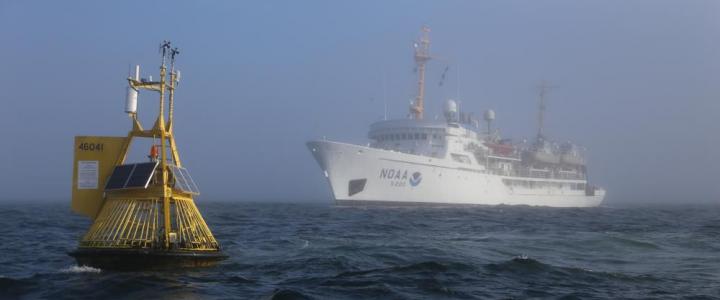The Ocean Carbon group has focused its efforts on understanding the ocean’s role in uptake and redistribution of natural and anthropogenic CO2 from the atmosphere. The details of this uptake and storage as well as the mechanisms controlling them are still not fully understood. Continued monitoring and scientific analysis of the ocean carbon cycle is critical to understand how the ocean sink for anthropogenic CO2 is functioning and how the carbon storage might change in the future. The group generates high-quality carbon data, quantifies global ocean carbon uptake and storage from repeat hydrography and VOS cruises, and acquires in situ measurements from moorings. They use multiple platforms to observe patterns and trends of carbon uptake and transport, as well as to provide critical model validation, and have used historical and newly compiled databases to develop data synthesis products. This work has led to a determination of seasonal to decadal trends in carbon fluxes and storage in the global oceans. Research publications based on these long-term data sets have led to a more comprehensive understanding of the ocean’s role in climate. The group plans to continue global repeat hydrographic cruises, including coastal cruises for model validation; broaden the CO2 mooring network to include physical, chemical, and biological sensors; expand the use of Argo floats, wave gliders, and Slocum gliders for CO2, pH, O2, and, ultimately, other inorganic carbon parameters; extend observations into new areas including the Arctic and subarctic seas; continue to advance technology for improved ocean carbon autonomous sensors and platforms; develop new syntheses, data products, and modeling efforts that provide critical information to other scientists, stakeholders, and the public; and publish papers on ocean carbon and acidification processes.
In the open and coastal oceans, the Ocean Carbon group is currently making high-quality measurements of ocean acidification parameters (dissolved inorganic carbon, total alkalinity, CO2 partial pressure, and pH), as well as ancillary properties, such as dissolved oxygen and nutrients that are related to ecosystem research. In order to understand spatial and temporal changes occurring in the world’s oceans, the OA program uses automated analytical systems on moorings and underway platforms. The program is in the process of adding pH, oxygen, chlorophyll, and turbidity sensors to these systems to more accurately and precisely study the changes associated with OA.
The Ocean Carbon group plans, as described in the Climate-Weather Research section, to expand the CO2/pH mooring network; extend observations into new areas; further develop the use of wave gliders. Slocum gliders, and Argo floats; advance new technology and data products; and disseminate critical information to other scientists, stakeholders, and the public. The Ocean Carbon group is partnering with EcoFOCI to increase the number of ocean acidification moorings in the high latitudes. In 2013, two EcoFOCI moorings (one in the Gulf of Alaska and the other in the Bering Sea) will be equipped with pCO2 sensors. In addition, the two programs will collaborate (ship time, equipment, and expertise) to introduce a third mooring in the Gulf of Alaska.



